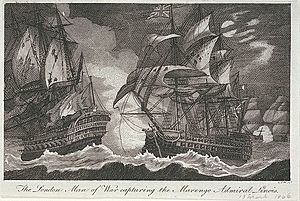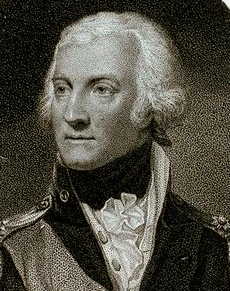Action of 13 March 1806 facts for kids
Quick facts for kids Action of 13 March 1806 |
|||||||
|---|---|---|---|---|---|---|---|
| Part of the War of the Third Coalition | |||||||
 The London Man of War capturing the Marengo Admiral Linois, 13 March 1806, "W. C. I." |
|||||||
|
|||||||
| Belligerents | |||||||
| Commanders and leaders | |||||||
| Strength | |||||||
| 7 ships of the line 1 frigate |
1 ship of the line 1 frigate |
||||||
| Casualties and losses | |||||||
| 40 killed and wounded | 175 killed and wounded 1 ship of the line captured 1 frigate captured |
||||||
The Action of 13 March 1806 was a naval battle during the Napoleonic Wars. It happened when British and French ships met by surprise in the middle of the Atlantic Ocean. Neither side knew the other was there.
The British group had seven large warships called ships of the line and some smaller frigates. They were led by Rear-Admiral Sir John Borlase Warren. Their job was to find and stop a French squadron led by Contre-Admiral Jean-Baptiste Willaumez.
The French group involved in this battle was much smaller. It had only one ship of the line and one frigate. These were the last ships of Contre-Admiral Charles-Alexandre Durand Linois's squadron. Linois had been attacking British merchant ships in the Indian Ocean for three years. He had some success against ships that weren't protected. However, he often backed away from strong British forces, like at the Battle of Pulo Aura.
By January 1806, Linois's ships were running out of supplies. French ports in the East that could help him were gone. So, Linois decided to sail back to France. In March, he accidentally sailed into the area where Warren's ships were patrolling.
Linois had failed to capture large British merchant ships twice before. When he saw some ships in the distance at 3:00 AM on March 13, 1806, he thought they might be another group of merchant ships. He decided to investigate with his ship, the Marengo. But he soon realized these were powerful warships. He was too close to escape the lead British ship, HMS London. As London attacked Marengo, the French frigate Belle Poule tried to get away. But the British frigate HMS Amazon caught up to her. Both fights lasted over three hours and were very bloody. The French ships surrendered after about three and a half hours. They lost nearly 70 sailors.
This battle ended Linois's three-year mission against British trade. It was also the second British victory in the Atlantic campaign of 1806. Linois was taken as a prisoner of war. Even though he had failed in the Indian Ocean, people thought he fought bravely in this battle.
Contents
Background to the Battle
By March 1806, the French squadron led by Contre-Admiral Charles-Alexandre Durand Linois had been active for three years. He was attacking British trade ships in the Indian Ocean. Linois had left France in March 1803, even before the Napoleonic Wars officially began.
He sailed to the South China Sea to try and capture a huge group of merchant ships. These ships, called the China Fleet, were carrying goods worth a lot of money. On February 15, 1804, Linois found the China Fleet. It was sailing without its usual British Navy escort. Losing this group of ships would have been a disaster for the British economy.
However, the commander of the merchant ships, Commodore Nathaniel Dance, tricked Linois. Dance made some of his large merchant ships look like warships. He then pretended to attack Linois's squadron from a distance. This made Linois believe he was facing strong warships. So, Linois decided not to attack and sailed away. Dance's merchant ships even chased the French for a bit! This event, known as the Battle of Pulo Aura, was very embarrassing for Linois. Napoleon was furious when he heard about it.
Six months later, Linois was near the Indian port of Vizagapatam. His ships met the British warship HMS Centurion and two merchant ships. In the fight, Centurion was badly damaged. One merchant ship was captured, and the other was forced ashore. But Linois did not finish off Centurion. He was afraid of damaging his own ships in the shallow waters. He pulled back again, which made Napoleon angry once more.
In August 1805, Linois met another group of British merchant ships. This time, he faced the warship HMS Blenheim. After a small skirmish, Linois again pulled away. He did not want to risk serious damage to his ships so far from a safe port. Over his three-year journey, he had captured some merchant ships. But he had not really hurt British trade much. His reputation as a naval commander was ruined.
Linois learned that a British squadron was looking for him. So, he decided to move his operations to the Atlantic. He visited the Cape of Good Hope, where one of his frigates was wrecked. He then sailed along the coast of West Africa. He captured two small ships but still didn't make a big impact on British trade. He heard that the British had captured Cape Town. So, Linois decided to return to France with his last two ships. These were his flagship, the 74-gun Marengo, and the frigate Belle Poule. He sailed north, crossing the equator on February 17.
Linois did not know he was sailing into a big series of movements by British and French ships. This was called the Atlantic campaign of 1806. On December 13, two large French squadrons had left France. They were ordered to attack British trade in the Atlantic. The British quickly sent three squadrons to chase them. One of these was led by Rear-Admiral Sir John Borlase Warren. He was sent to the mid-Atlantic.
The Battle Begins
On March 13, 1806, Warren's squadron was sailing in the Eastern Atlantic. Most of his ships were together. But HMS London and Warren's flagship HMS Foudroyant were sailing a bit apart. The frigate HMS Amazon was with them.
At 3:00 AM, lookouts on London saw sails in the distance. Captain Sir Harry Burrard-Neale of London quickly went after them. He signaled to Warren with blue lights. Warren followed with Amazon, and the rest of the British ships were behind.
To the north-east, Linois had also seen sails. He turned Marengo to chase them. He thought it was another group of valuable merchant ships. Captain Alain-Adélaïde-Marie Bruilhac of Belle Poule thought they were British warships. But Linois disagreed. He thought any warships would be part of the convoy's escort and could be avoided.
It wasn't until 5:30 AM that Linois realized his mistake. London appeared out of the darkness right in front of Marengo. Linois tried to escape. But his ships had been at sea for a long time and were slow. The 98-gun London quickly caught up to Marengo. London then opened fire with its powerful guns.
Fighting the French Ships
Linois fired back as best he could. But by 6:00 AM, he knew he was outmatched. He turned away and told Captain Bruilhac in Belle Poule to escape. However, the frigate kept firing at London to help Linois get away. At 6:15 AM, Bruilhac saw Amazon coming fast. He also pulled away. London kept firing at Marengo.
Both Marengo and London had damage to their rigging (the ropes and masts). This made it hard for them to move. Linois could not avoid Londons shots. He also couldn't avoid shots from Amazon as it chased Belle Poule. By 8:30 AM, Amazon was fighting Belle Poule. The two frigates exchanged fire for the next two hours. Amazon managed to damage Belle Poules rigging, stopping her escape.
Behind the frigates, Marengo was taking more hits from London. By 10:25 AM, Marengo also came under fire from Foudroyant and HMS Repulse. HMS Ramillies was also getting close. Facing so many powerful British ships, the French ship of the line had no choice but to surrender. The French flag was lowered at almost 11:00 AM. By then, both Linois and his captain, Joseph-Marie Vrignaud, were seriously wounded.
Almost at the same time, Captain Bruilhac surrendered Belle Poule. The damage from Amazon and the sight of Warren's entire squadron made him realize it was hopeless to fight on.
The French suffered heavy losses. Marengo was badly damaged. She lost 63 men killed and 83 wounded out of a crew of 740. This included Linois and his son, who were seriously hurt. Captain Vrignaud had to have his right arm removed. Belle Poule lost six killed and 24 wounded out of 330 men.
The British losses were much lighter. London had ten dead and 22 wounded. Amazon had four killed and five wounded. London was the only British ship damaged, mostly in her rigging. This was quickly fixed after the battle.
After the Battle
On April 23, a big storm hit the Eastern Atlantic. Warren's squadron and the captured French ships were caught in it. Marengo was badly damaged. She lost all three masts and took on a lot of water. Five men drowned. Ramilles also suffered, losing most of her masts. She rolled out of control for hours. Once the storm calmed down, temporary masts were put up. The scattered ships rejoined the squadron and sailed back to Britain.
The loss of Marengo and Belle Poule was a small part of the larger Atlantic campaign. But the defeat of Linois was celebrated in Britain. Both French ships were added to the British Navy. Linois was praised for defending his ship against such a strong British force. Historians later said that if Linois had only faced London, he might have won.
Linois was taken as a prisoner. Napoleon was still angry about Linois's past failures. He refused to exchange Linois for a British prisoner. Napoleon never let Linois command ships at sea again. After Napoleon stepped down in 1814, Linois became governor of Martinique. But when Napoleon returned for the Hundred Days, Linois supported him. The British then invaded and captured Martinique. Linois's naval career was over. He retired and died in 1848.
Images for kids




